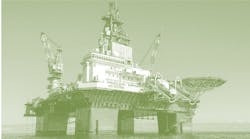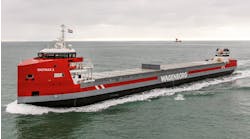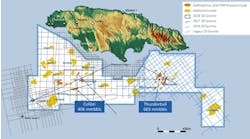- Cross-section of the Central Graben and western part of the Norwegian-Danish basin illustrating the migration of hydrocarbons to Siri. [11746 bytes]
- Currently licensed acreage off western Denmark [18100 bytes]
Last year was a morale-booster for Denmark's Energy Ministry. Estimated Danish oil reserves rose to a record 252mcm, helped by a series of improved recovery programs and Statoil's Siri discovery.
Oil and condensate production is set to rise from 11.8mcm this year to 13.8mcm in 2000, according to the Danish Energy Agency (DEA). These figures are based on known development plans. In theory, production could hit 19mcm/yr by the turn of the century if certain prospects were fast-tracked; but thereafter, a downward drift takes charge, whatever the scenario, which no amount of horizontal drilling or water injection on existing fields will offset. Denmark needs further new finds if it is to maintain hydrocarbon self-sufficiency.
At the moment, the portents aren't bad. Siri, discovered last fall in Tertiary sandstones close to the Norwegian median line, has rekindled interest in exploration off Denmark. The well was on 4th licensing round acreage only awarded in May 1995. On the other eight new 4th round licences, seismic work programs are expected to lead to possibly 13 further Danish exploration wells.
The DEA forecasts exploration expenditure of up to DKr400 million annually over the next few years. Another favorable factor is that state oil company DOPAS - a mandatory 20% stakeholder in all new licences - is now paying its share of exploration costs. Previously, these were waived.
Siri upgrade
Siri-1 is thought to be Denmark's largest oil discovery since Skjold in 1977. Potentially recoverable oil was initially put at 80MM bbl; however, a subsequent 3D survey over the surrounding acreage by Geco-Prakla suggests upside potential may be nearer 150MM bbl.
Aside from being large by Danish standards, this was also the country's first substantial find outside the Central Graben, and its first in Tertiary sandstone layers (numerous discoveries have been reported in the Norwegian and UK Tertiary). Siri-1 also confirmed that oil generated within the Central Graben has migrated over long distances: 25 km to the east in this case.
Statoil moved quickly to drill following a high resolution 2D survey last year that identified the prospect. Maersk Enhancer was due to spud a second well last month three km west of Siri-1.
The area around Siri has not been explored in great depth, but further wells are planned nearby, according to Carsten Pedersen, chief legal adviser at Dansk Olie & Naturgas. Speaking at the North Sea Annual Conference in London in May, he said that even in extensively drilled offshore sectors of Denmark that had previously yielded little, new exploration objectives are now being identified. High resolution 3D surveys over the Central Graben and the area to the north-east are revealing in detail reservoir layers that did not show up on 2D seismic sections.
The DEA is now pondering a further licensing round over the Central Graben, likely to be launched mid-1997 with awards in early 1998. But the agency has also been re-evaluating the exploration potential of East Denmark with DOPAS, based on knowledge built up since 1991. This region is considered high risk, as no mature source rocks have been identified.
An open door policy is under consideration for eastern offshore acreage seekers. Best prospects are thought to lie in the Norwegian-Danish Basin and the North German Basin.
Longer term, Denmark's best hopes for reserve replacement may be its colonial frontier provinces of the Faeroes and offshore West Greenland, where some exploratory activity is expected this summer. A first Faeroese licensing round should be announced next year, assuming demarcation line differences with the UK are overcome.
Developments
Aside from Statoil, Denmark's chief wake-up call has come from Amerada Hess, which has been buying up an asset base. Acquiring operatorship of licence 7/89 allowed it to appraise an old DUC discovery, named South Arne, in the northern Danish North Sea.
Amerada successfully tested oil an gas in Upper Cretaceous and Paleocene chalk zones in the north of this structure in 1994. Following a 3D survey last year, another well was spudded this spring in the north-east of the Arne block. Reserves are put currently at 40MM bbl and 50 bcf of gas.
Aside from toying with a floater or wellhead platform for the eventual development, Amerada is also evaluating options for a new gas pipeline to the Danish mainland to take supplies from other fields, as well as South Arne. Denmark's oil export line network may also need expanding: the current 14mcm capacity could be overburdened by extra oil from fast-track developments between 1998-2000.
The DEA forecasts overall spending in the Danish sector this year of DKr5 billion, much of this directed to the Dan and Tyra Field extension programs and to the new Harald Field development.
Harald is Denmark's biggest new production project. Maersk recently revised the development scheme, allowing the two separate gas accumulations to be developed from a single complex comprising a processing and wellhead platform bridge linked to a STAR accommodation platform. Three wells are being drilled at Harald West and two at Harald East, with gas heading to shore via the Tyra East facilities.
Harald West will be Denmark's first field to produce from a sandstone formation. The facilities could also handle production from Statoil's neighboring Lulita discovery.
Copyright 1996 Offshore. All Rights Reserved.


